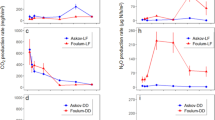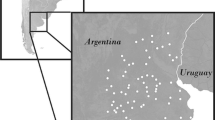Summary
Agro-ecosystems have developed from mixed- and multiple-cropping systems with relatively closed N cycles to intensively managed monocultures with large N inputs in the form of commercial fertilizers. Cultivation of increasingly larger areas of land has resulted in substantial losses of soil organic matter and N. Also, the move from slash and burn agriculture to intensively ploughed systems has resulted in losses through increased erosion.
The use of N fertilizers has increased rapidly toca. 60 Tg N yr−1 (1980/81), which is equivalent to at least 40% of the N fixed biologically in all terrestrial systems and 36% more than is fixed in all croplands. On a global scale, the major losses of N from agro-ecosystems are estimated to be: harvest, 30 Tg; leaching, 2 Tg; erosion, 2–20 Tg; denitrification 1–44 Tg; and ammonia volatilization, 13–23 Tg. However, the data base is very crude and several estimates may be wrong by as much as one order of magnitude.
Additions of N fertilizers have both direct and indirect effects on soil microorganisms. The possible importance of such effects is briefly discussed and a specific example is given on long-term effects on soil microbial biomass and nitrification rates in 27-year-old cropping systems with different N additions: (i) 0 kg N ha−1 yr−1, (ii) 80 kg N ha−1 yr−1, (iii) farmyard manureca. 80 kg N ha−1 yr−1.
Few detailed N budgets exist for agro-ecosystems, despite its major importance as a limiting plant nutrient and the large losses of N from such systems. In conclusion, preliminary nitrogen budgets for four cropping systems (barley receiving 0 or 120 kg N ha−1 yr−1; meadow fescue ley with 200 kg N ha−1 yr−1 and a lucerne ley) are presented, with special attention to N flow through the soil organisms.
Similar content being viewed by others
References
Ågren G I and Axelsson B 1980 Population respiration: a theoretical approach. Ecol. Modelling 11, 39–54.
Ahl T and Odén S 1975 Nutrient sources — an overview.In Eutrophication. 10th Nordic Symposium on Water Research. Nordforsk, Miljövârdssekretariatet Publ. 1975: 1, 99–133. Helsinki: Nordforsk. (In Swedish).
Allison F E 1955 The enigma of soil nitrogen balance sheets.In Advances in Agronomy, vol. 7. Ed. A G Norman. pp 213–250. Madison, Wisc.: American Society of Agronomy.
Anderson R V, Coleman D C and Cole C V 1981 Effects of saprotrophic grazing on net mineralization.In Terrestrial Nitrogen Cycles. Processes, Ecosystem Strategies and Management Impacts. Eds. F E Clark and T Rosswall. Ecol. Bull. (Stockholm) 33, 201–216.
Bååth E, Lohm U, Lundgren B, Rosswall T, Söderström B and Sohlenius B 1981 Impact of microbial feeding animals on total soil activity and nitrogen dynamics: a soil microcosm experiment. Oikos 37, 257–264.
Belser L W and Mayes E L 1980 Specific inhibition of nitrite oxidation by chlorate and its use in assessing nitrification in soils and sediments. Appl. Environ. Microbiol. 39, 505–510.
Berg P and Rosswall T 1983 Nitrification in arable land.In Third International Symposium on Microbial Ecology Abstracts, D-6, p. 35. East Lansing: Michigan State University.
Bremner J M and Blackmer A M 1981 Terrestrial nitrification as a source of nitrous oxide.In Denitrification, Nitrification and Atmospheric Nitrous Oxide. Ed C C Delwiche. pp 151–170. New York-Chichester-Brisbane-Toronto: John Wiley and Sons.
Burns R C and Hardy R W F 1975 Nitrogen Fixation in Bacteria and Higher Plants. Berlin-Heidelberg-New York: Springer-Verlag. 189 p.
Clarholm M 1983 Dynamics of Soil Bacteria in Relation to Plants, Protozoa and Inorganic Nitrogen. Ph. D. Diss Department of Microbiology, Swedish University of Agricultural Sciences Report No. 17, 19 p. Uppsala: Swedish University of Agricultural Sciences.
Clarholm M 1984 Interactions of bacteria, protozoa and plants leading to mineralization of soil nitrogen. Soil Biol. Biochem.Submitted.
Cooke G W 1982 Fertilizing for Maximum Yield. 3rd Edition. London-Toronto-Sydney-New York: Granada, 465 p.
Crutzen P J 1983 Atmospheric interactions — homogenous gas reactions of C, N and S containing compounds.In The Major Biogeochemical Cycles and Their Interactions. Eds. B Bolin and R B Cook. Chichester: John Wiley, Ltd. pp 67–112.
Darbyshire J F, Wheatley R E, Greaves M P and Inkson R M E 1974 A rapid micromethod for estimating bacterial and protozoan populations in soil. Rev. Ecol. Biol. Sol. 11, 465–475.
FAO 1981 Agriculture: Toward 2000. FAO Economic and Social Development Series No. 23. Rome: FAO: 134 p. plus annexes.
FAO 1982 FAO Fertilizer Yearbook 1981 Vol. 31. Rome: FAO.
FAO 1982 FAO Production Yearbook 1981 Vol. 35. Rome: FAO, 306 p.
Freney J R, Simpson J R and Denmead O T 1981 Ammonia volatilization.In Terrestrial Nitrogen Cycles. Processes, Ecosystem Strategies and Management Impacts. Eds. F E Clark and T Rosswall. Ecol. Bull. (Stockholm) 33, 291–302.
Firestone M K, Firestone R B and Tiedje J M 1979 Nitric oxide as an intermediate in denitrification: Evidence from nitrogen-13 isotope exchange. Biochem. Biophys. Res. Comm. 91, 10–16.
Frissel M J (Ed.) 1977 Cycling of mineral nutrients in agricultural ecosystems. Agroecosystems 4, 1–354.
Geus J G de 1973 Fertilizer Guide for the Tropics and Subtropics. 2nd Edition Zürich: Centre d'étude de l'azote, 774 p.
Gliessman S R 1982 Nitrogen distribution in several traditional agro-ecosystems in the humid tropical lowlands of south-eastern Mexico.In Nitrogen Cycling in Ecosystems of Latin America and the Caribbean. Eds. G P Robertson, R Herrera and T Rosswall. pp 105–117. Martinus Nijhoff/Dr W. Junk Publ., The Hague.
Greenland D J 1980 The nitrogen cycle in West Africa — Agronomic considerations.In Nitrogen Cycling in West African Ecosystems. Ed. T Rosswall. pp 73–81. Stockholm: SCOPE/UNEP International Nitrogen Unit, The Royal Swedish Academy of Sciences.
Grigg D B 1974 The Agricultural Systems of the World. An Evolutionary Approach, London: Cambridge University Press, 358 p.
Harlan J R, de Wet J M J and Stemler A B L 1976 Plant domestication and indigenous African agriculture.In Origins of African Plant Domestication. Eds. J R Harlan, J M J de Wet and A R Stemler. pp 3–19. The Hague-Paris: Mouton Publishers.
Heal O W and Maclean S F 1975 Comparative productivity in ecosystems — secondary productivity.In Unifying Concepts in Ecology Eds. W H van Dobben and R Lowe-McConnell. pp 89–108. The Hague: W Junk and Wageningen: Pudoc.
Jansson S L and Simán G 1978 Nitrogen Economy and Energy Yield in Swedish Agriculture, Especially Plant Husbandry. THE Report No. 3, 50 p. Stockholm: Tekniska Högskolornas Energiarbetsgrupp. (in Swedish)
Jones P C T and Mollison J E 1948 A technique for the quantitative estimation of soil microorganisms. J. Gen. Microbiol. 2, 54–69.
Linneman H, de Hoogh J, Keyzer M A and Van Heemt H D J 1979 MOIRA. Model of International Relations in Agriculture. Amsterdam-New York-Oxford: North-Holland Publishing Co., 379 p.
Lipschultz F, Zafirion O C, Wofsy S C, McElroy M B, Valois F W and Watson S W 1981 Production of NO and N2O by soil nitrifying bacteria. Nature London 294, 641–643.
Martinez A and Diamond R B 1982 Fertilizer use statistics in crop production. IFDC Technical Bulletin T-24, 37 p. Muscle Shoals, Alabama: International Fertilizer Development Centre.
Meybeck M 1982 Carbon, nitrogen and phosphorus transport by world rivers. Am. J. Sci. 282, 401–450.
Okigbo B N 1980 Farming systems of West Africa in relation to nitrogen cycling.In Nitrogen Cycling in West African Ecosystems. Ed. T Rosswall. pp 131–156. Stockholm: SCOPE/UNEP International Nitrogen Unit, The Royal Swedish Academy of Sciences.
Persson J 1980 Detailed studies of organic matter turnover in permanent plots. Department of Soil Science, Section for Plant Nutrients Report 128 (In Swedish). Uppsala: Swedish University of Agricultural Sciences.
Persson T 1983 Influence of soil animals on nitrogen mineralization in a northern Scots pine forest.In New Trends in Soil Biology. Eds. Ph Lebrun, H M André, A de Medts, C Gregoire-Wibo and G Wanthy. pp 117–126. Proc. of VIII Intl Colloquium of Soil Zoology. Louvain-la-Neuve, Belgium: Imprimeur Dieu-Brichart.
Persson T, Bååth E, Clarholm M, Lundkvist H, Söderström B E and Sohlenius B 1980 Trophic structure, biomass dynamics and carbon metabolism of soil organisms in a Scots pine forest.In Structure and Function of Northern Coniferous Forest—An Ecosystem study. Ed. T Persson. Ecol. Bull. (Stockholm) 32, 419–459.
Rosswall T 1977 Exchange of nutrients between atmosphere and vegetation-soil. Agro-Ecosys. 4, 296–302.
Rosswall T 1982 Microbiological regulation of the biogeochemical nitrogen cycle.In Nitrogen Cycling in Ecosystems of Latin America and the Caribbean. Eds. G P Robertson, R Herrera and T Rosswall. pp 15–34. The Hague: Martinus Nijhoff/Dr W. Junk Publ.
Rosswall T, Johansson C, Berg P, Klemedtsson L and Svensson B H 1983 Nitric oxide emission from arable soil as influenced by fertilizer additions.In manuscript.
Sánchez P A 1982 Nitrogen in shifting cultivation systems of Latin America.In Nitrogen Cycling in Ecosystems of Latin America and the Caribbean. Eds. G P Robertson, R Herrera and T Rosswall. pp 91–103. The Hague: Martinus Nijhoff/Dr W. Junk Publ.
Schnürer J and Rosswall T 1982 Fluorescein diacetate hydrolysis as a measure of total microbial activity in soil and litter. Appl. Environ. Microbiol. 43, 1256–1261.
Schnürer J, Clarholm M and Rosswall T 1983 Soil microbial biomass and activity in five 27-year-old agricultural management systems.In Third International Symposium on Microbial Ecology Abstracts, N-1, p. 61. East Lansing: Michigan State University.
Söderlund R and Svensson B H 1976 The global nitrogen cycle.In Nitrogen, Phosphorus and Sulphur — Global Cycles. Eds. B H Svensson and R Söderlund. SCOPE Report 7. Ecol. Bull. (Stockholm) 22, 23–73.
Söderström B 1977 Vital staining of fungi in pure cultures and in soil with fluorescein diacetate. Soil Biol. Biochem. 9, 59–63.
Stanford G and Smith S J 1972 Nitrogen mineralization potential of soils. Soil Sci. Soc. Am. Proc. 36, 465–472.
Steen E, Jansson P-E and Persson J 1984 Site description of the experimental field of the ‘Ecology of Arable Land’ project. Acta Agric. Scand.In press.
Watters R F 1971 Shifting Cultivation in Latin America. FAO Forestry Dev. Paper 16. Rome: FAO.
Author information
Authors and Affiliations
Additional information
Keynote address
Rights and permissions
About this article
Cite this article
Rosswall, T., Paustian, K. Cycling of nitrogen in modern agricultural systems. Plant Soil 76, 3–21 (1984). https://doi.org/10.1007/BF02205563
Issue Date:
DOI: https://doi.org/10.1007/BF02205563




